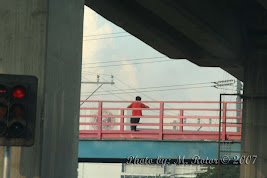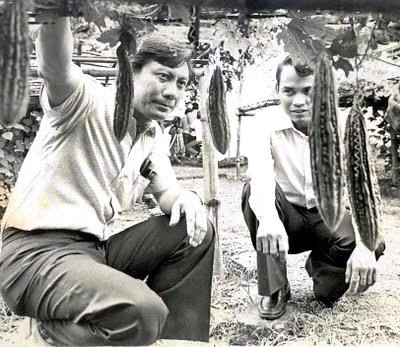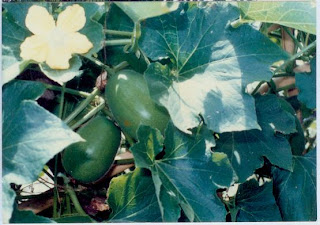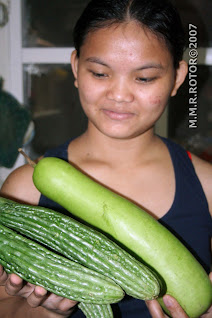Perhaps a review of these may lead us to find their application today, and to offer opportunities for further research. Ironically there are now fewer researchers in this field, and the quality of research has greatly declined. This is a general observation in many schools.
It is not the intention of research alone to prove a theory or hypothesis; it is equally valuable in disproving it as well, in erasing false beliefs and providing the basis of decision and judgment to conflicting opinions.
Paradoxically, as we move by leaps and bounds with scientific and technological progress, we cannot help to look back at conventional values and tradition. For example, more and more people are craving for native varieties of plants and breeds of animals, rejecting or adamant accepting genetically modified organisms (GMO).
People are willing to pay premium for food grown with organic matter instead of chemical fertilizers, fruits and vegetables which did not receive chemical spraying, meat and poultry which are free of residual antibiotics, and fish bearing no trace of toxins carried through the food chain.
A. Natural Pesticides and antibiotics
Suha (Citrus maxima) and tanglad (Antropogon citratus) can be formulated into an insecticide against common houseflies (Musca domestica). As a spray solution prepared from one ml of the volatile oil extracted from these plants to one liter of water, it is effective against adult flies. The flies were killed within one to one- half hours after direct spraying. 1/
The search for alternative antibiotics as answer to the dwindling potency of conventional penicillin group antibiotics brought researcher back to the drawing table, this time to take a second look at plants growing within reach of the common man.
A decoction of garlic (Allium sativum) at 40 gm per 100 ml water was found to inhibit the growth of Staphylocccus aureus, a bacterial pathogen that causes infection of wounds. While the area of inhibition (antibiosis) under laboratory condition is lower than those obtained with the penicillin and Prostaphlin, two commercial antibiotics, ( 2.25 mm versus 2.7 and 3.31 mm respectively), still garlic is recommended as a home remedy because it is safe and practical. 2/ Faculty and staff of SPUQC visit a barangay project
as part of the school's outreach program in San Juan MM
A follow-up research on the antibiotic properties of guava, (Psidium guajava) proved the efficacy of the decoction of its leaves (250 ml of the extract to 1 liter water) in controlling the bacterial pathogens, Staphylococcus aureus, Escherichia coli, S. typii, and S. dysenteriae.3/
Another potential antibiotic against diarrhea is mayana (Coleus blumei). Under laboratory condition using the nutrient agar medium, a decoction of mayana leaves, at 75g per 100ml, can effectively control S. aureus and E. coli. The local remedy is more effective on S. aureus which is gram-negative than on the gram-positive E.coli. The efficacy can be compared to those Omnipen and Ampicillin, two commercial antibiotics.4/
Can we identify plants which posses certain medicinal properties, such as diarrheal, without subjecting it to the conventional laboratory procedure? Initial experiments using thin layer chromatography established positive indications on the antidiarrheal property of guava (P. guajava), camito (C. cainito) and avocado (P. americana). More advanced chromatography can now be used in improving this technique. 5/
The use of anesthetic substitutes is not new. Even when I was young, I knew from experience that ikmo (Piper ikmo), a climbing plant growing in the backyard, when chewed, deadens the taste bud as well as soothes toothache. I witnessed a dentist in Bolinao, Pangasinan, use ikmo as local anesthesia in tooth extraction. A ball of ground fresh young leaves of guava was later administered to seal the wound to stop the bleeding. An experiment was conduct at SPCQ using Indonesian queen (Justicia genderusa) and Bulacan wonder (Cleome viscosa) as topical anesthesia.
The extract of these plants can be made into ointments that are applied to aching joints and muscles. Although the test was made on white mice, it was able to establish the basis of a potential formula. Equal proportion of the dried leaf extract of either plant with petroleum jelly. The extract is prepared by first drying the leaves before they are ground. Ethyl alcohol is used as solvent, and because it is volatile, it leaves behind powder sediment that is the dry extract itself. A stronger dosage may be formulated for faster and longer anesthetic action. 6/
On the village level, fresh extract is made by simply macerating and grinding the fresh leaves. The sap is recovered by straining the juice with a fined one-shade piece cloth. It is allow drying with the aid of the ethyl alcohol before it is blended with petroleum jelly. Fresh extract may be used and massaged over the effected parts of the body with coconut oil. Cleome was found to have a higher anesthetic action.
B. BT is Insect Specific
I had the chance to work on Bacillus thuringensis way back in the early sixties. However, it was only in the eighties that the microbiological agent, a bacterium discovered and developed in Thuringen, Germany, became a biological control agent against moths and butterflies. It is also effective in controlling insects outside order Lepidoptera?
Dr. Anselmo S. Cabigan, professor in biology at the SPCQ and former director for research of the National Food and Authority, tested BT on other major insect pest. two BT preparation were made- as spray and bait – and tested on the common housefly ( Musca domestica) of the Order Diptera. The BT inoculant was developed following a protocol named after the author.7/
At one percent concentration, either as spray or bait, mortality rate reached up to 44 percent of the housefly larvae (maggots) treated. Since the site of the experiment is an open poultry house, subsequent generations of flies followed during the experiment. The study however was inadequate to determine if BT can effectively carry out a continuous and sustaining epidemic on the entire population of the pests irrespective of the life cycle of the organisms and stage of generation.
Earlier researches proved the effectiveness of BT on fruit fly (Dacus dorsalis), a major pest of mango and other fruits. The pathogen killed mostly maggots in their early stage. Both bait and spray methods of application were effective with the former having a slight advantage. 8/
Does BT work on stored grain pests? This time the experiment was on weevil, order Coleoptera. tested BT on Lesser Grain Borer (Rhizopertha dominica) just as in the previous experiment, the inoculants were derived through the same Protocol. The preparation at 1 percent concentration (inoculants in dried papaya pulp medium) with road dust was applied to stored rice with the assurance by DOST that BT has no harmful effect applied directly with stored grains. Result: BT cannot control the Coleopterous pest. The explanation is that beetles are protected by thick exoskeleton and the moisture in the grain is too low to activate the Bacillus spores. 9/
Similarly BT was applied on a stored corn grain to protect it from infestation. To the question, "Can BT serve as protectant against possible insect pest?” Arabella Caralde, BS biology 1998, came with up a negative result. Again, this is because BT spores can remain dormant under highly dry condition. Stored corn grains, like rice, contain average 14 percent moisture, fluctuating very little under ambient condition.
Next was a test on the effectiveness of BT against American Cockroach (Periplaneta americana), a cosmopolitan household pests inhabiting kitchens and dirty places. Again, the result obtained was negative. 10/
Dr. Cabigan and I discussed the result of the BT experiments. We arrived at the conclusion that definitely BT is insect specific. It is designed for caterpillars, the feeding stage of Lepidopterans. The ingested bacterial cells and spores produce toxin that acts in the gut of the insect causing the destruction of epithelial cells and consequently resulting in the death of organisms. Multiplication of bacterial cells continues even on the dead larva. Resting cells are formed and become ready for next round of infection, thus setting the momentum of epidemic, say in cornfields where corn borers abound. As long as condition are favorable for the pathogen, the host caterpillars become “sick” and ultimately die; thus BT can provide long-term protection to the crop.
Even if the toxin is effective on other insects as demonstrated by the experiment on houseflies, the mechanism of a biological control on caterpillars has yet to be established and proven to be as effective.
The significance of research then is not only to prove a hypothesis. It is equally valuable in disproving a claim or belief as shown in the BT experiments. BT is not a universal biological agent. It disproves claims on the effectiveness of BT by commercial manufacturers.
C. Aflatoxin
Aflatoxin is a carcinogenic by-product of the fungus, Aspergillus flavus, which invades poorly dried and damaged copra, peanut, and corn and other cereals and seeds. When both man and animals take these products, the toxin may cause cirrhosis of the liver.
What happens to chicken fed with aflatoxin-tainted feed? The amount of Aflatoxin in commercial feeds is insignificant to affect broilers. Besides, the rearing period (5 weeks) is too short to allow accumulation and expression of the toxin.11/
For humans however, aflatoxin may accumulate in the liver and the consequence may be detected only after the long period. The suspected sources of aflatoxin that enters the human body are beer (brewed from the aflatoxin tainted cereals), peanut butter (inferior peanut separated from the whole seeds and ground into peanut butter), “moldy” rice, corn and other food. It is no wonder that many beer drinkers are victims of cirrhosis. Personally, I believe that it is not the alcohol that is the main cause because beer contains less than 5% alcohol. It is the grain, like binlid (broken rice), that is the source of aflatoxin. There is little research on aflatoxin in the Philippines todate.
Author with Dr Cabigan. Photo taken at the former St Paul Museum
QC, circa 2005
D. Substitute Tea and Coffee
Tea from leaves of pandan (Pandanus odoratissimus), sambong (Ocimum bacilicum) was formulated singly and in combination, and the product was tested through organoleptic analysis. A blend of the three plants gave a superior result, compared to any single formulation. The reason is that certain desirable characters of each component were combined. For example, basil gave the best color, flavor and texture, while pandan gave the best aroma, sambong contributed to the fullness and desirable taste of the composite product. 12/
In another experiment, Oolong tea (semi-fermented, slightly bitter tea) was prepared from the immature leaves of avocado (Persia americana), banaba (Lagerstroma speciosa), tsaang gubat (Carmona retusa), and caimito (Chrysophyllum cainito ), the contribution of each component was determined by organoleptic test with tsaang gubat giving the desired color, banaba the taste , and avocado, together with caimito, the texture and flavor proposed is that blending may be modified in order to suit the taste of the drinker.13/
This is also true with another experiment, this time black tea from sambong, pandan and avocado by Michelle B. Deliguin, The leaves are first withered then airs dried, brewed and made into tea. Sambong gave the desired color, pandan the aroma and avocado texture. An increase in the amount of pandan improved the taste of the blend.
Coffee substitutes have been the quest of those who have sensitive nerves. Even decaffeinated coffee in not the guarantee to many people. On the farm, we used a number of substitutes such as rice or corn roasted until the color is rich brown. Cacao with coffee may reduce the latter’s effect but this is expensive and cacao is not readily available. Besides, cacao has another nerve-acting property, theobromine, which is even stronger than caffeine acting as stimulant.
Another substitute which is clandestinely added to native coffee or kapeng barako (Coffea liberica) is seed of ipil-ipil (Leucaena glauca). This is NOT recommended. Ipil-ipil contains mimosin, which retards growth causes baldness. That is why the use of ipil-ipil leaves to animals is limited. Stunted growth (bansot) and loss of hair in piglets are traced to the effects of mimosin.









.jpg)









.jpg)








0047.JPG)





















































.jpg)
































































